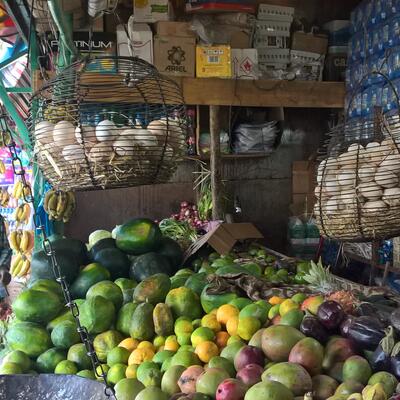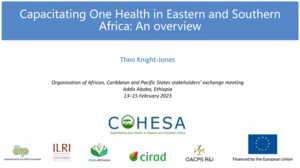
On a frugal continent of ‘economic vegetarians’, consuming more meat means longer, healthier lives—Economist
A slaughterhouse in Maputo, Mozambique (photo credit: ILRI/Stevie Mann).
The Economist reports that the future of food lies in Africa. And why that’s a good thing. Read on to find out why.
As Africans get richer, they will eat more meat and live longer, healthier lives
‘. . . Between 1961 and 2013 the average Chinese person went from eating 4kg of meat a year to 62kg. Half of the world’s pork is eaten in the country. More liberal agricultural policies have allowed farms to produce more—in 1961 China was suffering under the awful experiment in collectivisation known as the “great leap forward”. But the main reason the Chinese are eating more meat is simply that they are wealthier.
In rich countries people go vegan for January and pour oat milk over their breakfast cereal. In the world as a whole, the trend is the other way.
‘In the decade to 2017 global meat consumption rose by an average of 1.9% a year and fresh dairy consumption by 2.1%—both about twice as fast as population growth. Almost four-fifths of all agricultural land is dedicated to feeding livestock, if you count not just pasture but also cropland used to grow animal feed. Humans have bred so many animals for food that Earth’s mammalian biomass is thought to have quadrupled since the stone age (see chart).
‘Barring a big leap forward in laboratory-grown meat, this is likely to continue. The Food and Agriculture Organisation (fao), an agency of the un, estimates that the global number of ruminant livestock (that is, cattle, buffalo, sheep and goats) will rise from 4.1bn to 5.8bn between 2015 and 2050 under a business-as-usual scenario. The population of chickens is expected to grow even faster.
The chicken is already by far the most common bird in the world, with about 23bn alive at the moment compared with 500m house sparrows.
Meanwhile the geography of meat-eating is changing.
The countries that drove the global rise in the consumption of animal products over the past few decades are not the ones that will do so in future.
‘. . . On a planetary scale, the rise of meat- and dairy-eating is a giant environmental problem. Locally, however, it can be a boon. . . .
‘It is largely through eating more pork and dairy that Chinese diets have come to resemble Western ones, rich in protein and fat. . . .
‘Last year China overtook Brazil to become the world’s second-biggest beef market after America, according to the United States Department of Agriculture. . . . [E]ven as the Chinese develop the taste for beef, Americans are losing it. Consumption per head peaked in 1976; around 1990 beef was overtaken by chicken as America’s favourite meat. . . .
Despite eager predictions of a ‘second nutrition transition’ to diets lower in meat and higher in grains and vegetables, Western diets are so far changing only in the details.
‘Beef is a little less popular in some countries, but chicken is more so; people are drinking less milk but eating more cheese. The EU expects only a tiny decline in meat-eating, from 69.3kg per person to 68.7kg, between 2018 and 2030. Collectively, Europeans and Americans seem to desire neither more animal proteins nor fewer.
‘If the West is sated, and China is getting there, where is the growth coming from? One answer is India. Although Indians still eat astonishingly little meat—just 4kg a year—they are drinking far more milk, eating more cheese and cooking with more ghee (clarified butter) than before. In the 1970s India embarked on a top-down “white revolution” to match the green one. Dairy farmers were organised into co-operatives and encouraged to bring their milk to collection centres with refrigerated tanks. Milk production shot up from 20m tonnes in 1970 to 174m tonnes in 2018, making India the world’s biggest milk producer. The OECD expects India will produce 244m tonnes of milk in 2027. . . .
But neither an Indian milk co-operative nor a large Chinese pig farm really represents the future of food.
Look instead to a small, scruffy chicken farm just east of Dakar, the capital of Senegal.
‘Some 2,000 birds squeeze into a simple concrete shed with large openings in the walls, which are covered with wire mesh. . . . The chickens in the shed hardly resemble the variegated brown birds that can be seen pecking at the ground in any number of villages. They are commercial broilers—white creatures with big appetites that grow to 2kg in weight after just 35 days. All have been vaccinated against two widespread chicken-killers—Newcastle disease and infectious bursal disease. . . .
Official statistics suggest that the number of chickens in Senegal has increased from 24m to 60m since 2000. . . .
Many sub-Saharan Africans still eat almost no meat, dairy or fish. . . . This is seldom the result of religious or cultural prohibitions. If animal foods were cheaper, or if people had more money, they would eat more of them. . . .
Yet this frugal continent is beginning to sway the global food system.
The UN thinks that the population of sub-Saharan Africa will reach 2bn in the mid-2040s, up from 1.1bn today. That would lead to a huge increase in meat- and dairy-eating even if people’s diets stayed the same. But they will not. The population of Kenya has grown by 58% since 2000, while the output of beef has more than doubled.
‘Africa already imports more meat each year than does China, and the OECD’s forecasters expect imports to keep growing by more than 3% a year. But most of the continent’s meat will probably be home-grown. The FAO predicts that in 2050 almost two out of every five ruminant livestock animals in the world will be African. The number of chickens in Africa is projected to quadruple, to 7bn.
‘This will strain the environment. . . . Sub-Saharan Africans currently have tiny carbon footprints because they use so little energy—excluding South Africa, the entire continent produces about as much electricity as France. The armies of cattle, goats and sheep will raise Africans’ collective contribution to global climate change, though not to near Western or Chinese levels.
People will probably become healthier, though.
Many African children are stunted (notably small for their age) partly because they do not get enough micronutrients such as Vitamin A. Iron deficiency is startlingly common. . . .
Poor nutrition stunts brains as well as bodies.
‘Animal products are excellent sources of essential vitamins and minerals. Studies in several developing countries have shown that giving milk to schoolchildren makes them taller. Recent research in rural western Kenya found that children who regularly ate eggs grew 5% faster than children who did not; cow’s milk had a smaller effect. . . .
‘Africans’ changing diets also create opportunities for local businesses. . . .
‘It is often said that sub-Saharan Africa lacks an industrial base, and this is true. . . . But to look only for high-tech, export-oriented industries risks overlooking the continent’s increasingly sophisticated food-producers, who are responding to urban demand. Ideally, Africa would learn to fill shipping containers with clothes and gadgets. For now, there are some jobs to be had filling bellies with meat.’
Read the whole article at The Economist: The way of more flesh: Global meat-eating is on the rise, bringing surprising benefits, 2 May 2019.






















